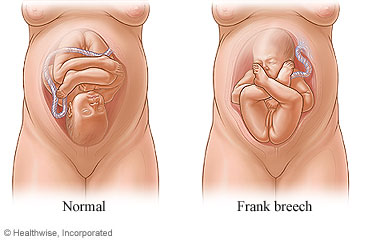Turning a Breech Baby: Care Instructions

Overview
At the end of most pregnancies, the baby's head is near the birth canal (vagina). But sometimes a baby's rear end or feet are near the birth canal. This position is called breech.
If your baby stays in this breech position, you will probably need a caesarean section (C-section). Most breech babies are healthy and don't have problems after birth.
Your doctor may try to turn your baby. To do this, the doctor presses on certain places on your belly. Sometimes this causes the baby to turn. The medical name for this process is external cephalic version.
During the process of trying to turn your baby, your doctor will carefully watch your uterus. There's a chance that the pressure and movement might start contractions. There's also a chance that the umbilical cord will twist or get damaged.
If your baby turns, your doctor may send you home. But the doctor will check you often until your labour starts. If your baby's head stays down, you may be able to have a vaginal delivery. But a small number of babies move back into a breech position.
Follow-up care is a key part of your treatment and safety. Be sure to make and go to all appointments, and call your doctor or nurse advice line (811 in most provinces and territories) if you are having problems. It's also a good idea to know your test results and keep a list of the medicines you take.
How is the procedure done?
- Your doctor will give you medicine to relax your uterus. Your doctor may give you medicine for pain and to help you relax.
- Your doctor will put both hands on your belly. One hand will be near the baby's head. The other hand will be near the baby's rear end. The doctor will push and roll the baby to try to get the head down.
- You may feel some pain. The doctor will ask you how you are doing.
- Your doctor will use a heart monitor to see how your baby is doing.
- After the process, your doctor will give you instructions for your care.
When should you call for help?
Call 911 anytime you think you may need emergency care. For example, call if:
- You passed out (lost consciousness).
- You have severe vaginal bleeding. This means you are soaking through a pad each hour for 2 or more hours.
- You have sudden, severe pain in your belly or pelvis.
Call your healthcare provider, midwife, or nurse advice line now or seek immediate medical care if:
- You have new or worse vaginal bleeding.
- You are dizzy or light-headed, or you feel like you may faint.
- You have pain in your belly, pelvis, or lower back.
- You have a sudden release of fluid from your vagina.
- You think that you are in labour or are having contractions of your uterus with or without pain (6 or more in 1 hour).
- You are in your third trimester, and you notice that your baby has stopped moving or moves less than 6 times in 2 hours.
Watch closely for changes in your health, and be sure to contact your healthcare provider, midwife, or nurse advice line if you have any problems.
Where can you learn more?
Go to https://www.healthwise.net/patientEd
Enter I027 in the search box to learn more about "Turning a Breech Baby: Care Instructions".
Adaptation Date: 09/06/2023
Adapted By: Alberta Health Services
Adaptation Reviewed By: Alberta Health Services
